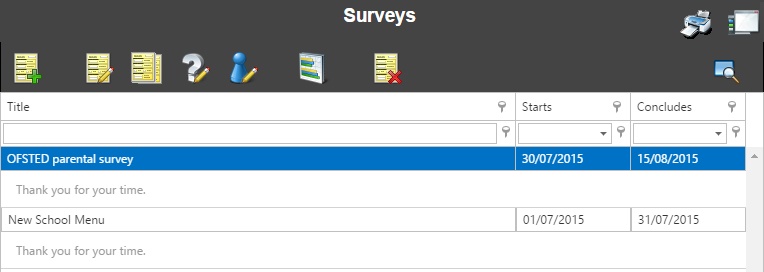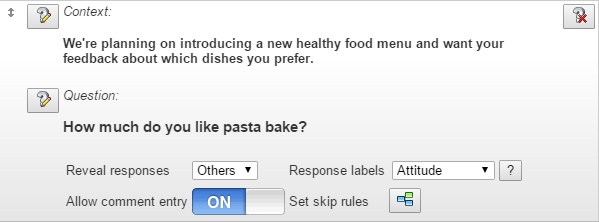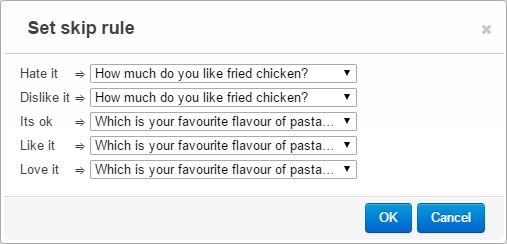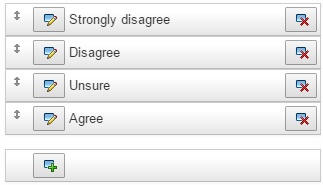Difference between revisions of "Surveys"
| Line 2: | Line 2: | ||
Insight can be used to create and publish surveys to parents or pupils. When there is an available survey, users will be prompted to take part when they log in, and the results can analysed. <br> <br> | Insight can be used to create and publish surveys to parents or pupils. When there is an available survey, users will be prompted to take part when they log in, and the results can analysed. <br> <br> | ||
| − | + | =Creating a Survey= | |
The survey page will show a list of all of the surveys that have been created so far. <br> <br> | The survey page will show a list of all of the surveys that have been created so far. <br> <br> | ||
| Line 34: | Line 34: | ||
Once a survey has been created, you will need to add questions to the survey and decide who the survey is sent to. <br> <br> | Once a survey has been created, you will need to add questions to the survey and decide who the survey is sent to. <br> <br> | ||
| − | + | ==Survey Questions== | |
A survey needs to have questions assigned to it. Select a survey then click the Questions button. Each question can be given an optional context, which is additional text to help explain the question. <br> <br> | A survey needs to have questions assigned to it. Select a survey then click the Questions button. Each question can be given an optional context, which is additional text to help explain the question. <br> <br> | ||
| Line 52: | Line 52: | ||
[[Image:surveys_skip_rules.jpg]] <br> <br> | [[Image:surveys_skip_rules.jpg]] <br> <br> | ||
| − | + | ==Response labels== | |
Click on the Response Labels Button to toggle the response labels. Each response label contains a set of answers that users can give for each question and can hold a maximum of 5 answers. Users will see the answers as either rating stars or buttons. <br> <br> | Click on the Response Labels Button to toggle the response labels. Each response label contains a set of answers that users can give for each question and can hold a maximum of 5 answers. Users will see the answers as either rating stars or buttons. <br> <br> | ||
| Line 72: | Line 72: | ||
[[Image:response_label_answers.jpg]] <br> <br> | [[Image:response_label_answers.jpg]] <br> <br> | ||
| − | + | ==Participants== | |
Once you have created your survey, it must be issued to users. Select the survey and click the Participants Button. This will open a window where you can select students. <br> <br> | Once you have created your survey, it must be issued to users. Select the survey and click the Participants Button. This will open a window where you can select students. <br> <br> | ||
| Line 78: | Line 78: | ||
The survey will be issued to every user that is linked to the students you select. Use the groupings on the left to select specific groups of students. You can either click the Add All Button to add all pupils from a group, or click on specific pupil names to add only those pupils. <br> <br> | The survey will be issued to every user that is linked to the students you select. Use the groupings on the left to select specific groups of students. You can either click the Add All Button to add all pupils from a group, or click on specific pupil names to add only those pupils. <br> <br> | ||
| − | + | =How the survey appears to users= | |
| − | + | =Analysing results= | |
To see the aggregated results from a survey, first select the survey by clicking on the row in the main table, then click on the "Analyse results" tool-bar button. You will see a breakdown of the number of users invited who participated to give you an idea of how reliable your sample size is in considering the results of any question. The buttons to the right of this allow you to view all comments associated with the survey, or to print the analysis summary. <br> <br> | To see the aggregated results from a survey, first select the survey by clicking on the row in the main table, then click on the "Analyse results" tool-bar button. You will see a breakdown of the number of users invited who participated to give you an idea of how reliable your sample size is in considering the results of any question. The buttons to the right of this allow you to view all comments associated with the survey, or to print the analysis summary. <br> <br> | ||
Revision as of 10:19, 4 August 2015
| Additional Module |
Insight can be used to create and publish surveys to parents or pupils. When there is an available survey, users will be prompted to take part when they log in, and the results can analysed.
Contents
Creating a Survey
The survey page will show a list of all of the surveys that have been created so far.
On the top toolbar there are a number of buttons to manage and analyse surveys.
Click on the Add button to create a new survey. A survey will need a title a start date and an end date. Surveys can also be given an introductory message and a note for users when they complete the survey.
Once a survey has been created, you will need to add questions to the survey and decide who the survey is sent to.
Survey Questions
A survey needs to have questions assigned to it. Select a survey then click the Questions button. Each question can be given an optional context, which is additional text to help explain the question.
The response label option allows you to choose the answers that parents are allowed to give. You can click the Question Mark Button to see the answers that go with each of the Response Labels.
If you allow users to view others' responses, they will be able to see what percentage of other users have chosen each response.
Questions can also be reordered. Click and drag using the up/down arrow icon at the top left of the question.
Skip rules can be used if you want users to skip some questions if they give particular answers. For example, if you have a question "How much do you like pasta bake?" and a user answers "Not at all", then there isn't much point in asking which flavour of pasta bake is their favourite.
Click the Skip Rules Button and a window will open showing the various answers available, according to the Response Labels. For each possible answer, you can decide which question the user will be taken to. If you select Completion, then the survey will be finished if/when the user selects that answer.
Response labels
Click on the Response Labels Button to toggle the response labels. Each response label contains a set of answers that users can give for each question and can hold a maximum of 5 answers. Users will see the answers as either rating stars or buttons.
There are 3 buttons next to each of the Response Labels.
| Button | Effect |
|---|---|
| Edit the name and display of the Response Label | |
| Edit the answers available in the Response Label | |
| Delete the Response Label |
To add, edit or delete response labels within a response label type, click on the Edit Labels Button. In the pop-up window, use the "Add" button to enter a new response label; an "Add" button will not be shown if there are already five response labels. You can reorder the answers by dragging them using the up/down icon on the left of each answer.
Participants
Once you have created your survey, it must be issued to users. Select the survey and click the Participants Button. This will open a window where you can select students.
The survey will be issued to every user that is linked to the students you select. Use the groupings on the left to select specific groups of students. You can either click the Add All Button to add all pupils from a group, or click on specific pupil names to add only those pupils.
How the survey appears to users
Analysing results
To see the aggregated results from a survey, first select the survey by clicking on the row in the main table, then click on the "Analyse results" tool-bar button. You will see a breakdown of the number of users invited who participated to give you an idea of how reliable your sample size is in considering the results of any question. The buttons to the right of this allow you to view all comments associated with the survey, or to print the analysis summary.
Below this, each question is listed with an indicator of how the participants responded. The button to the right of the panel shows you the comments entered specifically for that question.
You can click on any response to see which of the participants gave the selected response.
Click the "X" button in the top right of the pop-up window to close it.



